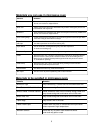
8
COOKING GUIDE
COOKING PRINCIPLES AND TECHNIQUES
The advantages of microwave cooking are speed and efficiency.
For warming, heating, and defrosting, nothing compares. Here are a few tips that will make microwave
cooking easier and more enjoyable.
Microwave Cooking Principles:
Because microwave cooking requires only one-quarter to one-third the time of conventional cooking, the same
cooking principles become even more important.
Quantity:
During microwave cooking, the cooking time is dependent on the amount of food placed inside the oven.
If you double the recipe, plan on doubling the cooking time.
Density:
Dense foods, such as potatoes, need more cooking time as it takes longer for microwave energy to penetrate
and conduct heat through them.
Shape and Size:
Cut food into uniform shapes and sizes for even cooking. When cooking irregular shapes (such as chicken
pieces), place the thicker parts to the outer edge of the dish.
Cooking Time:
Food high in moisture, sugar or fat cook faster. Add a minimum amount of liquid to moisten foods. An excess
amount of water will slow the cooking process.
Starting Temperature:
Frozen or refrigerated foods take longer to microwave than food at room temperature.
Delicate Ingredients:
Delicate foods such as eggs, cheese, mayonnaise, etc., cook very quickly, and should be watched carefully.
Microwave Cooking Techniques:
Arranging:
Arrange food in a circular pattern, with denser, thicker portions facing toward the
outer edge of the dish.
Piercing: Pierce the membrane of foods such as eggs, oysters, snails, sausages, liver,
clams and whole vegetables, so they do not burst.
Re-heating: Cooked foods reheat extremely well using a lower power level of microwave energy. Place
denser foods near the outer edge of the dish when re-heating.
Covering: Most foods will cook and reheat better when covered. Keep the cover loose (not tight) Always
pierce plastic wraps to allow steam to vent.
Stirring: It is recommended to occasionally stir foods during cooking, as this will help
food cook more quickly and evenly.
Turning Over: To promote even cooking, turn larger solid items such as roasts or baked potatoes over,
halfway through the cooking time.
Standing Time: Foods continue cooking even after removal from the oven. Standing time is necessary to
allow foods to complete cooking/defrosting.
Converting Recipes: Microwave recipes will likely call for less liquid and cooking
time than conventional cooking.
Microwave Thermometers: For best results, a microwave-safe thermometer can be carefully and properly
inserted into the food. Keep in mind that standing time is essential for most food to reach its proper serving
temperature.


















